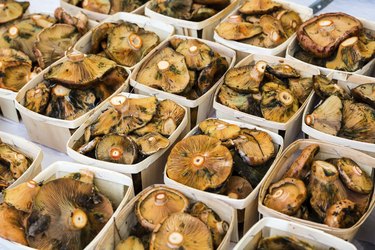
Fungi may seem like something you'd never want to eat. However, people commonly eat fungi, such as mushrooms, in their favorite dishes. However, if you accidentally eat unsafe fungi, such as mold that grows on soft or porous foods, it can make you ill. Understanding what fungi are, the types and what happens if you eat fungi will help you stay healthy when deciding what foods to consume daily.
Definition
Video of the Day
Many types of fungi exist, and they live in various environments on the earth. Some fungi flourish on land and others thrive in water. Although a part of the plant family, fungi don't have chlorophyll like other types of plants and aren't self-sustaining. Some species of fungi are single-celled organisms, and other types are multicellular. To survive, some fungi are parasites, or they feed on decay, and other fungi survive through symbiosis. All fungi have a purpose and function in the grand ecosystem, but if you eat certain fungi, you can become very ill or even die. Some fungus is edible and is also used for its medicinal properties.
Video of the Day
Mushrooms
All mushrooms are fungi, and there are 10,000 known types of mushrooms with some yet to be identified. Those used for cooking, such as truffles and Portobello mushrooms, are part of many well-known dishes. Many of the edible mushrooms are also known and utilized for their healing properties, such as shitake and oyster mushrooms, according to University of Kentucky.
However, some mushrooms are poisonous, and it's important to know the difference between safe mushrooms and unsafe mushrooms. Any wild mushroom is potentially dangerous. To truly be safe, only eat mushrooms that can be purchased in a grocery store. In the U.S., there are about 100 known species of wild mushrooms that are poisonous to humans if eaten, and some are deadly. Fatalities have occurred even with known safe mushrooms, especially when eaten by small children and sick or weak adults. Some people are also allergic enough to safe mushrooms that they become ill, and even people who aren't allergic can have reactions to safe mushrooms if they eat too many of them.
Yeasts
Yeasts are also part of the kingdom Fungi, and some are edible, such as yeast used in baking or alcohol fermentation. You're not likely to ingest other types of yeast, unless it's by great accident. Washing your hands often can help you avoid accidental ingestion of infectious yeast. Some common ailments caused by infectious yeast include athlete's foot, swimmer's ear and Candida, or yeast infection, but these aren't typically caused by ingesting the infectious yeast.
Mold and Mildew
Molds and mildews are types of fungi that can make you quite ill if you accidentally ingest them, causing symptoms such as nausea and diarrhea. Mold growing on leftover food, such as soft cheese, can also have harmful bacteria growing along with it, including listeria or salmonella. You can eat certain foods once the mold and surrounding areas are completely removed, such as cheddar or Swiss cheese. However, mold can grow long roots making most food not suitable for eating even once it appears you've removed the mold. If you notice mold fungi on your food, it's best not to eat it and to dispose of it immediately. Mildew is mold in its early stage, according to FEMA. Avoid ingesting mildew since its effects are the same as eating mold.